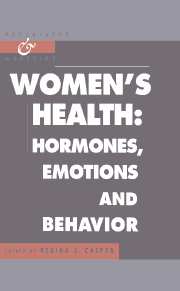Book contents
- Frontmatter
- Contents
- Preface
- 1 Growing up female
- 2 Reproduction and its psychopathology
- 3 Women's sexual function and dysfunction
- 4 Gender differences in brain morphology and in psychiatric disorders
- 5 Thyroid hormones in major depressive disorder and bipolar disorder
- 6 The hypothalamic-pituitary-adrenocortical system
- 7 The cost of starvation: Eating disorders
- 8 Coronary artery disease and women: Estrogens and psychosocial and lifestyle risk factors
- 9 The psychophysiology of breast cancer: Disease, hormones, immunity, and stress
- 10 The psychopharmacology of women
- 11 Intervention trials concerned with disease prevention in women
- References
- Index
4 - Gender differences in brain morphology and in psychiatric disorders
Published online by Cambridge University Press: 08 February 2010
- Frontmatter
- Contents
- Preface
- 1 Growing up female
- 2 Reproduction and its psychopathology
- 3 Women's sexual function and dysfunction
- 4 Gender differences in brain morphology and in psychiatric disorders
- 5 Thyroid hormones in major depressive disorder and bipolar disorder
- 6 The hypothalamic-pituitary-adrenocortical system
- 7 The cost of starvation: Eating disorders
- 8 Coronary artery disease and women: Estrogens and psychosocial and lifestyle risk factors
- 9 The psychophysiology of breast cancer: Disease, hormones, immunity, and stress
- 10 The psychopharmacology of women
- 11 Intervention trials concerned with disease prevention in women
- References
- Index
Summary
Epidemiologic and clinical studies in psychiatry consistently reveal gender-based differences in the prevalence and manifestations of certain psychiatric disorders. In particular, women may be more vulnerable to developing depressive or anxiety disorders, whereas men may be more prone to substance-related disorders. Other conditions, such as schizophrenia or bipolar disorder, occur with a relatively imilar frequency in men and women, yet differ in age of illness onset, symptomatology, illness course, and treatment response. These dissimilarities have implications in terms of clinical management as well as in our heuristic understanding of the etiologies of various psychiatric conditions. Sex differences in brain anatomy and function may underlie certain gender biases in psychiatric disorders or possibly confer protective or predisposing influences in the development of psychiatric illness. However, other factors are also important, such as genetic predisposition, endocrine status, and sociocultural issues. Part I of this chapter discusses the fundamental processes underlying sexual differentiation of the brain and the ramifications on brain structure and function. Part II consolidates the literature on gender differences in psychiatric illnesses and provides an overview of gender differences in the prevalence, clinical features, proposed mechanisms, and nonpharmacologic treatments of six major psychiatric conditions – major depression, bipolar affective disorder, alcoholism, anxiety disorders, somatization disorder, and schizophrenia. Given the range of subject matter covered in this chapter, references to more extensive reviews on each topic are provided. Psychopharmacologic issues are discussed in Chapter Ten.
Keywords
- Type
- Chapter
- Information
- Women's HealthHormones, Emotions and Behavior, pp. 53 - 82Publisher: Cambridge University PressPrint publication year: 1997
- 5
- Cited by



